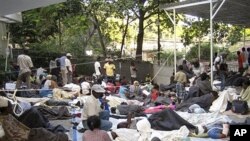The United Nations is urging cities to put in place disaster reduction plans to withstand natural hazards that affect a growing number of people.
The United Nations reports more than half the world's population is living in urban areas. It says cities are particularly vulnerable to the risks of natural hazards, such as earthquakes, droughts and floods, because of overcrowding and increased pressure on resources,
It says eight out of 10 of the largest cities in the world, including Tokyo, New York, Mexico City and Mumbai, are at risk of being severely affected by an earthquake.
It says climate related disasters such as flooding, flash floods, tropical cyclones, drought, wildfires and heat waves now affect more people worldwide.
U.N. Special Representative for Disaster Risk Reduction Margareta Wahlstrom says cities in Africa are at particular high risk because they are growing faster than anywhere else.
"Many cities actually have very limited resources to keep up the speed to get correct infrastructure, sanitation, electricity, drainage-making sure you build on safe land," Wahlstrom said. "You know there are many situations where people have actually built informal settlements on polluted land, which has created huge difficulties for the government and the population."
U.N. agencies are planning a two-year global campaign aimed at making cities more resilient to natural hazards. The campaign hopes to enlist more than 1,000 local government leaders worldwide to invest more in disaster risk reduction.
Measures include improving urban planning, infrastructure and building safety; reinforcing drainage systems to reduce flood, storm and health threats and installing early warning systems.
Wahlstrom says leaders from Saint Louis, Senegal; Kampala, Uganda, and Dar Es Salaam, Tanzania along with several other cities already have joined the campaign.
She says this is an opportunity for cities to use scarce resources better.
'"The bottom line of reducing disaster risk is that you reduce the cost. It is much more costly to pay the damage of a destroyed bridge than building better when you build it," Wahlstrom said. "And, the same thing for hospitals and schools, all the experience globally shows that sometimes it is an issue of four-percent increased cost to build a really safe hospital or a school, rather than build one that risks collapsing."
Wahlstrom says political leaders will be rewarded if they ensure their countries are safer. She says it has taken earthquake-prone Tokyo 50 years to make buildings safer and its people aware of what must be done to protect themselves from disaster.
UN: Disaster Reduction Plans Can Help Cities Withstand Natural Hazards
- By Lisa Schlein









